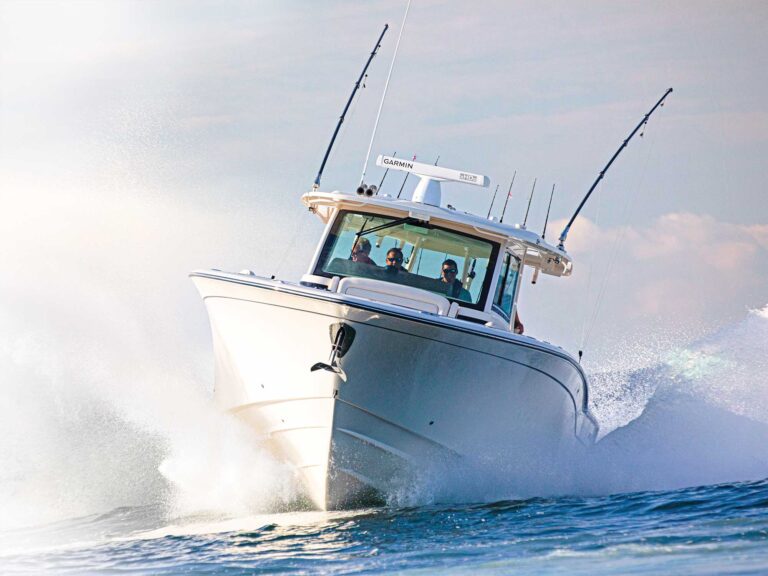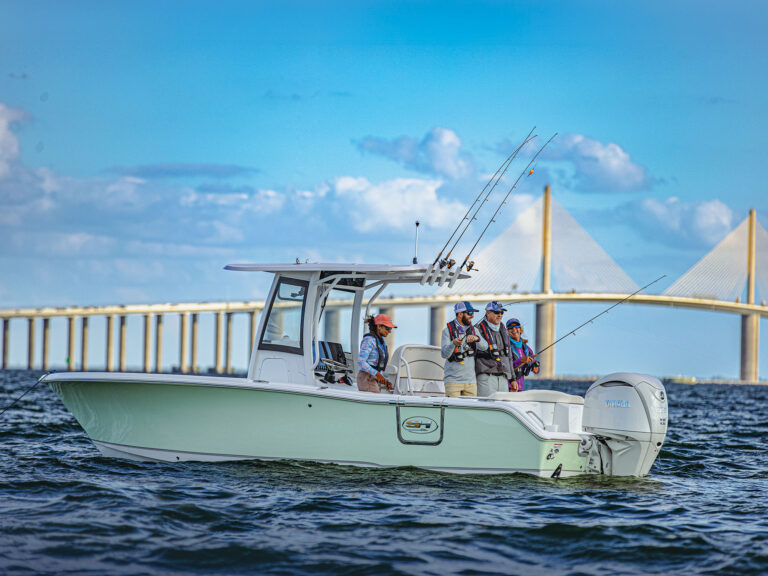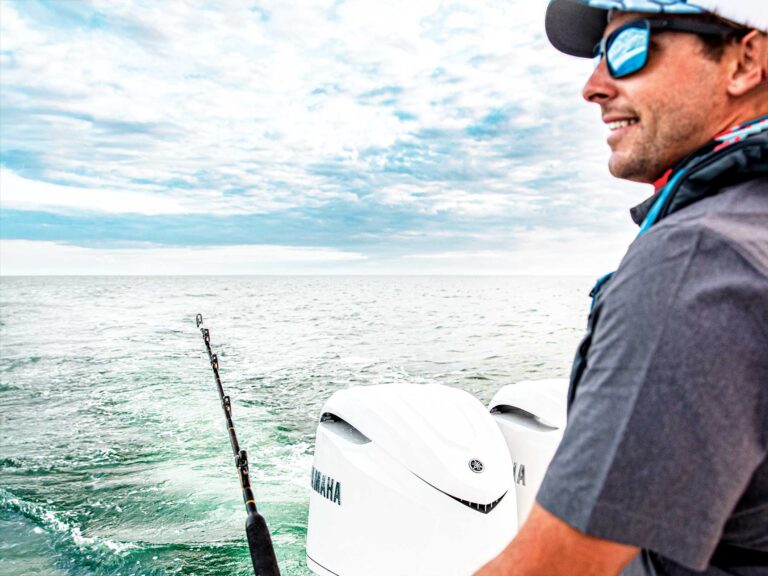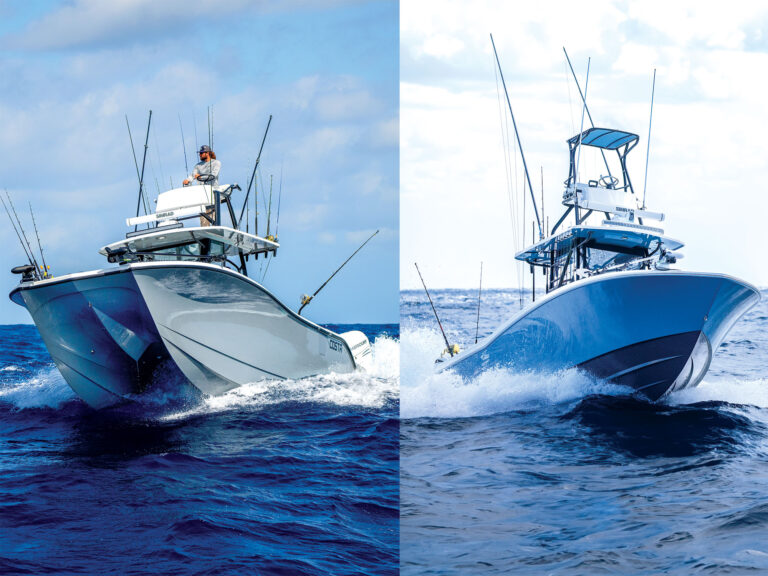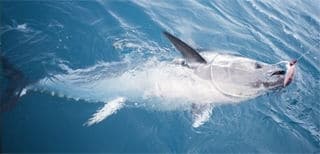
| The first bluefins to show on Cape Lookout Shoals typically run 200 to 300 pounds. As the season progresses, bigger fish take their place. |
It was the dead of winter. sea Smoke rolled off the warm gulf stream waters of the outer Banks of North Carolina. Giant Bluefin tuna boiled on the surface of the ocean like bluegill in a pond. Throw a fatback – the Outer Banks moniker for giant menhaden – in the water and a hole would open up as bluefins up to 600 pounds rolled up and took the dead bait off the surface.
Dan Rooks, mate on the Tuna Duck, put big circle hooks through identical baits and tossed them over the transom. Like clockwork, the fish hit. We waited for Rooks to give the signal, then threw the huge reels into gear and stood straight up in the chair, arms groping backwards for something to hang on to. Some of us were nearly pulled overboard, some of us got sick, some of had our backs go out, and some of us had to use both hands to turn the reel handle. But one by one we strapped ourselves into the bucket harness and mounted the chair for a chance to have our arms stretched by giant bluefin tuna. After two fish each, we were ready to go home.
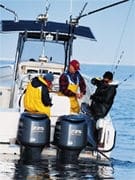
Tuna action off Cape Lookout takes place close to shore, allowing anglers in small and midsized boats to get in on the action. Here the author, in red hat, and Anthony Ng welcome a 200-pounder aboard.|
This was 1996, just a couple years after the discovery of schools of giant bluefin tuna off the Outer Banks of North Carolina. Anglers from all over the country were rushing to take part in what was then a brand-new fishery, anxious to do battle with one of the finest fighters in the ocean. All at once it seemed we were knee-deep in the legendary fish many of us felt we would never have an opportunity to catch. Suddenly they were pretty easy. We didn’t know how long the situation would last or if it even would. It has.
Now it’s a reliable fishery. From Manteo south to Cape Lookout Shoals, a steady stream of anglers continue to make the winter trek to the Outer Banks to pull on what is arguably the most magnificent fish that swims.
Shallow-Water Phenomenon
Originally the action was centered off Hatteras, where the bait and the tuna schooled over the shallow wrecks in 150 to 170 feet of water. The past few years has seen the rapid development of angling techniques for the waters off Morehead City, to the south. The waters around Cape Lookout Shoals offer great access for small boats, and the shallower water has driven the development of new techniques for cashing in on this spectacular fishery. The fish are the same fish, but the techniques for catching them are different.
The fishery here differs considerably from the one farther north. If you think catching bluefins in 150 feet is shallow, you should try ten feet of water. It makes the fish act differently, and consequently different tactics are called for.
| ## Tackling a GiantSTAND-UP GEAR Big boats that carry a fighting chair rely on 80- and 130-pound, bent-butt rods, but with the proper setup, stand-up gear can fight giant bluefins just as effectively, and is the way to go when fishing from smaller center-console boats. Joe Shute prefers 100-pound-class stand-up rods and Shimano Tiagra 50LRS reels for fish in the 200- to 400-pound range. He spools up with 600 yards of 130-pound Verstex Battle Line, a gel-spun braided line. Terminal tackle is 130-pound mono wind-on leader and eight feet of 280-pound fluorocarbon coming off a Sampo ball-bearing swivel. This allows the swivel to hit the rod tip with eight feet of leader remaining outside the tiptop. “In a small boat especially,” says Shute, “this is much safer for the wireman and a lot less confusing.”When the big fish arrive in January, Shute says, “That’s when I switch to the 80 Tiagra with the same line. This heavier drag lets me handle the 400- to 600-pound fish.”Brant McMullan also prefers stand-up gear and relies on Tiagra 50s and Penn 50s loaded with 130-pound Dyneema, a braided line. Onto this he splices 100 to 200 yards of 80- or 100-pound mono, “to provide the stretch I like to have on the strike,” he says. McMullan packs 600 yards total on the reels and finishes with a 200- to 300-pound fluorocarbon leader for dead-bait trolling or 100-pound fluorocarbon for live-baiting.When catching so large a fish for release, it’s important to use enough tackle. Make the fight short and hard through proper selection of adequate gear and you’ll fare better and the fish will recover quicker when released.- Glenn Law |
Captain Joe Shute of Atlantic Beach guides and fishes the Cape Lookout area through the entire winter season, and has a good handle on what to expect. According to Shute, the first fish show up in the middle of November every year and it is the serious king mackerel fishermen who usually – much to their dismay – encounter the fish first. They know the bluefins are in when something hits their baits and cleans them out, something they can’t stop.
“The first fish in November,” says Shute, “come in from across the Atlantic. They are skinny, and run 200 to 300 pounds on average. By the middle of December either those fish have done a good job of feeding, or new fish come in, fish that run between 200 and 500 pounds.”
Biggest Fish Come Later
As the winter progresses and the weather gets colder, the fish get larger. “By January the largest fish are in, and they often run between 400 and 600 pounds,” says Shute. “After February the fish begin to move offshore, down off the Big Rock.
“When the first fish show up in the fall, we start fishing at Cape Lookout from the trawler-boat buoy on out. They hang out around the R-6 buoy through the end of November.”
When the fish are in this shallow water, Shute fishes them by trolling horse ballyhoo rigged on 7691 Mustad 11/0 hooks. Often he will pull the ballyhoo behind a blue-and-crystal chrome head or pink-and-pink Ilander lure. Normally a trolling speed of five to seven knots will do the job. The fish will move back and forth across Cape Lookout Shoals, traveling from the west to the east side and back again, in ten to 60 feet of water. Just about every day the bite starts a half-hour before daylight, and is over by nine or ten in the morning. “Generally all the boats hook up by 8:30, and by the time you land your fish, nobody is hooked up anymore,” says Shute.
Unique Tagging Study
On a mid-winter excursion to Morehead City last February, my experience bore out Shute’s observations. Fishing with Joey Weller of Grady-White Boats and Anthony Ng of Fish-Ng Accessories, it was ballyhoo that did the trick. Fishing with two Grady-White factory teams, we caught a fish each on successive days, and each time it was trolled ballyhoo in 40 to 60 feet of water that did the job. And on both days, the action was constant throughout the fleet for the first several hours of the day.
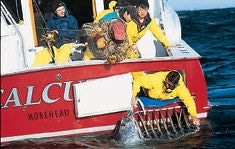
This team of marine biologists capitalized on the success of area anglers by implanting radio tags in the fish that were to be released.|
It was easy to tell who in the fleet had fish on. The tagging team, lead by Barbara Block from Stanford University had chartered a distinctive red boat for the season. Anglers wishing to cooperate with the researchers put the word out on the radio when they had a fish solidly on. The tagging boat then raced to intercept the fish before it was too worn out to handle the tagging procedure. Once on the scene, the tagging boat took the tuna onto a line, then into the cockpit to implant the radio tags being used to track the fish.
Transferring a live tuna from one boat to another is fascinating exercise. Here’s how it’s done: The boat with the tuna on radios the research boat, which then determines the position of the boat with the fish and races to it. Once alongside, the research boat throws a tennis ball with a fishing line attached to it into the cockpit of the boat fighting the fish. The mate leaders the fish and fastens the tag boat’s line to the leader. Then an assistant in the fighting chair fights the tuna over to the tag boat. A special aluminum cradle below the transom door allows the fish to be slid into the cockpit, where the team of taggers surgically implants a radio tag, sews the fish up and slides it back out the transom door for release. It’s a complex choreography, expensive and complicated, but this program is providing data that may well play a vital role in the survival of giant bluefin tuna.
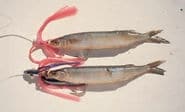
Horse ballyhoo rigged behind skirted lures are trolled off Cape Lookout to find the fish.|
According to Shute, because the fish around Cape Lookout are in such shallow water, they are much spookier than they are off Hatteras. If you plan on catching them by chunking – that is, chumming them with menhaden, then slipping in a bait with a hook in it – it has to be from a dead boat with the motors and electronics turned off to create a minimum of disturbance. Or you can use other tactics developed by small-boat anglers.
Trolled Ballyhoo Technique
Captain Brant McMullan has been fishing the giant bluefins successfully for several seasons out of a 27-foot center console, the Carolina Contender. His preferred method of finding fish is to troll ballyhoo. He likes to use a downrigger in over 50 feet of water.
“We also use a No. 8 commercial planer off downriggers,” he says. “We run the bait 50 to 100 yards back, then put a paper clip on the line and slide it down.”
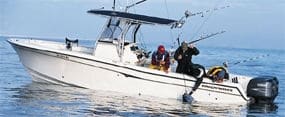
After a long fight, the author and crew attempted to tag and release this giant, but unfortunately the fish died and was kept for the dinner table. If you plan to keep a fish, make sure you have a permit before heading out.|
Once the fish are located, McMullan say the most exciting way to fish them is to slow-troll live menhaden. It’s a demanding method, but also one of the most effective, and one of the most thrilling ways to catch tuna.
“The hard part about live-baiting is finding the menhaden,” McMullan admits. “The trick here is to find the gannets – big, white-and-black birds. They will be on the bait. And once you find the bait, you have usually found the tuna.”
McMullan says the menhaden schools hold in different depths, and he has found them from 12 feet or so out to 75 feet. When the bait is holding in 30 feet of water or less, all it takes is a castnet to gather enough baits for a morning’s fishing. McMullan prefers a one-inch mesh, sinks a small gillnet and lets it sit for four or five minutes to collect enough baits.
| ## Keep ‘Em or Release ‘Em?* TO EAT OR NOT NOT TO EAT? Heavy gear and short fights keep most bluefins strong enough to be released successfully. If you want to keep one, bear in mind that yellowfin tuna is generally accepted to be better table fare. Bluefin is fine fresh, but you can only eat so much sushi. And be sure you know how to bleed and cool the fish once you get it in the boat. Tuna heat up when they are fighting, and the fish can actually cook itself and go bad if not bled and cooled properly. ¿ * TO KEEP A FISH YOU NEED A PERMIT from the National Marine Fisheries Service, available through www.nmfspermits.com. Make sure you have a permit and know the regs. In general, the recreational category bag limit is one fish measuring from 47 to 73 inches per day per vessel and one fish per year measuring 73 inches or above. But this can change rapidly and you have to stay abreast of the regulations and changes by monitoring the NMFS website. The permit fee is $27 for the season, which runs from June through May.- Glenn Law |
“All we need is half a dozen baits,” he says. “We use a 10/0 circle hook on a 100-pound fluorocarbon leader. It’s light, but in a small boat it’s a lot safer, and the lighter leader allows the bait to swim better. The lighter gear works well because we have found the fish are a lot more docile if you are not dragging them around at three to five knots. They don’t seem to fight as hard the way we fish them.
“Most people don’t want to go through the trouble of fishing live baits, but it’s an incredible way to catch tuna. You put out two or three baits and you never catch just one fish. It’s almost always multiple hook-ups. And what is really exciting is the way they hit. They will skyrocket the live baits – you always get some kind of explosion on the strike.”
There are probably as many approaches to catching giant bluefins off the Outer Banks as there are anglers doing it. Overall, once the fish are located, it isn’t a big deal to get them hooked up. The fish are in the shallows to feed, and if you present them a bait, they’ll usually take it.
The special thing about these fish is not that it is so hard to get them to hit, it’s the thrill and the pleasure to be had in finding one of the world’s great trophy game fish so accessible to so many anglers, and so willing to tussle.
| ## Charter CaptainsTo fish with the charter captains mentioned in this article, contact:Capt. Brant McMullan (910) 754-4454 www.captainbrant.comCapt. Joe Shute’s Bait & Tackle (252) 240-2744 (800) 868-0941 www.captjoes.comCapt. Jerry Shepherd (252) 986-2257 www.tunaduck.comAlso, check out other N.C. captains in this month’s “The Traveling Fisherman” section. |





